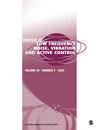A novel method for noise reduction of blade tip timing signals based on sparse representation and dictionary learning
IF 2.4
4区 工程技术
Q1 ACOUSTICS
Journal of Low Frequency Noise Vibration and Active Control
Pub Date : 2023-09-11
DOI:10.1177/14613484231200856
引用次数: 0
Abstract
Blade Tip Timing Technology (BTT) is a new type of blade vibration measurement method with non-contact measurement capabilities, which is associated with high efficiency and convenience. However, due to under-sampling feature of the BTT signal, the method can only measure part of the vibration information. Therefore, various BTT spectral reconstruction algorithms have been developed based on the under-sampling feature and sparsity of the blade vibration spectrum. Because of the harsh working environment of the blades, BTT signal typically contains high-level Gaussian noise in actual measurement, which significantly reduces frequency-domain sparsity and even aliases the vibration modals, resulting in a decrease in the performance of sparse reconstruction algorithms. In this paper, a multi-sequences BTT signal noise reduction method is proposed, which is based on sparse representation to suppress Gaussian noise. Through appropriately modifying the constraint in the ℓ0 optimization problem, the method filters out the noise elements in the sparse vector of the BTT signal. Then, denoising is completed by sparse inverse transformation. Finally, a global average-based singular value decomposition dictionary learning algorithm (GA-K-SVD) is proposed to generate an over-complete sparse dictionary which is adaptable to the original signal, to increase the effectiveness of GA-K-SVD. At last, simulation and experience are carried out to verify the performance optimization effect for sparse reconstruction algorithm and the effectiveness of proposed noise reduction method.一种基于稀疏表示和字典学习的叶片定时信号降噪方法
叶尖定时技术(BTT)是一种新型的叶片振动测量方法,具有非接触式测量能力,具有效率高、方便等特点。然而,由于BTT信号的欠采样特性,该方法只能测量部分振动信息。因此,基于叶片振动频谱的欠采样特征和稀疏性,开发了各种BTT频谱重建算法。由于叶片工作环境恶劣,实际测量中BTT信号通常含有高水平的高斯噪声,导致频域稀疏度明显降低,甚至振动模态混叠,导致稀疏重建算法性能下降。提出了一种基于稀疏表示抑制高斯噪声的多序列BTT信号降噪方法。该方法通过适当修改优化问题中的约束条件,滤除BTT信号稀疏向量中的噪声元素。然后,通过稀疏逆变换完成去噪。最后,提出了一种基于全局平均的奇异值分解字典学习算法(GA-K-SVD),生成适应原始信号的过完备稀疏字典,提高了GA-K-SVD算法的有效性。最后通过仿真和经验验证了稀疏重建算法的性能优化效果和所提降噪方法的有效性。
本文章由计算机程序翻译,如有差异,请以英文原文为准。
求助全文
约1分钟内获得全文
求助全文
来源期刊

Journal of Low Frequency Noise Vibration and Active Control
Engineering-Mechanical Engineering
CiteScore
4.90
自引率
4.30%
发文量
98
审稿时长
15 weeks
期刊介绍:
Journal of Low Frequency Noise, Vibration & Active Control is a peer-reviewed, open access journal, bringing together material which otherwise would be scattered. The journal is the cornerstone of the creation of a unified corpus of knowledge on the subject.
 求助内容:
求助内容: 应助结果提醒方式:
应助结果提醒方式:


